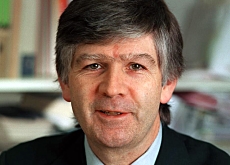“This is an acceptable compromise”

Switzerland's Walter Kälin, who drew up the blueprint for the UN's new Human Rights Council, speaks to swissinfo about the genesis of his "baby".
The council was approved by the United Nations General Assembly on Wednesday, despite opposition from the United States, and will replace the discredited Human Rights Commission.
Kälin, a renowned expert on humanitarian and international law, admits that the new UN body is not all he hoped for but says it will make a difference.
In his 2004 paper, “Towards a UN Human Rights Council: Options and Perspectives”, Kälin outlined three possible models for the council: small (15-25 members), medium (50-60 members) and large (universal membership).
Key elements included making the council one of the principal organs of the UN, giving it more “teeth” to tackle states that violate human rights, and ensuring two to three regular sessions throughout the year with the option of emergency meetings.
The Geneva-based commission, which meets once a year for six weeks, has been widely criticised for allowing some of the worst offenders to escape sanction.
swissinfo: Are you happy with the end result or has your baby been turned into a monster?
W.K.: Well, it’s not exactly what I would have wished for but if we look at it realistically, it’s a good resolution. I do not think that if discussions had continued we would have got anything better. I rather fear that if discussions had continued it would have been weakened, diluted and then it would not have been big progress or real reform.
swissinfo: At the outset you identified a clear need to give the council more “teeth”. What did you have in mind?
W.K.: More teeth means being able to react to new situations of gross and systematic human rights violations quickly, and I felt that you would need a permanent body, not meeting every day but throughout the year.
I also felt that we would need a body that has more authority and is less selective, because up to now some countries have been shielded against scrutiny and criticism for political reasons even though there was a human rights problem.
One of the strong points of the council is that there will be a regular review of each and every country. This will really help to identify problems.
swissinfo: The body we have ended up with is closest to Model B. But you said in your paper that there is a danger of a body this size taking “an overly political approach to human rights issues”.
W.K.: The task was to find a balance between different requirements: expertise, legitimacy, effectiveness and representation. This brings you to a model between a very small and a very big body. I didn’t at the time give any preference because the aim was to launch a debate and not to propose one model. But I already felt then that I myself would probably opt for Model B.
swissinfo. The US favoured a smaller body of around 30 countries. What are the arguments against this?
W.K.: We live in a world with lots of tension between states and regions, and I think with a very small body we would have ended up with even more politicisation, especially at the time of electing the few members.
Also in a very small body it is very difficult to have regional representation, which is crucial to the UN system, and the limited number of seats would have excluded many states that deserve to be on the council.
swissinfo: In your paper you failed to touch on how countries should be elected to the council. The Swiss and the United States among others favoured a two-thirds majority. Do you have a preference?
W.K.: I would have very much favoured the two-thirds majority because I feel it would have made it possible either to keep certain countries out or to put pressure on countries to commit to approaching the work of the human rights council in at least a minimally positive spirit.
Now we didn’t get that but we still have it to a certain extent, just the other way round. The General Assembly can terminate the membership of states that commit gross and systematic violations of human rights with a two-thirds majority. This is a compromise, but it’s an acceptable compromise.
swissinfo-interview: Adam Beaumont in Geneva
Negotiations on the new rights body endured for several months after running into difficulty over how membership should be decided.
Under the resolution accepted on Wednesday, the current 53-member commission will be replaced by a 47-member council elected by an absolute majority of the 191-member General Assembly.
Human rights expert Walter Kälin says it was significant that Amnesty International and Human Rights Watch, both strong critics of the commission, supported the resolution.
Walter Kälin is a professor of constitutional and international public law at Bern University.
He was asked by the Swiss government in 2003 to prepare a study on reforming the Human Rights Commission. His paper formed the basis for the new council.
In 1991-1992, he was the UN’s special rapporteur on human rights in Iraqi-occupied Kuwait.
Since 2003 he has been a member of the UN Human Rights Committee.
In 2004 he was appointed as UN Secretary-General Kofi Annan’s representative on the human rights of internally displaced persons.

In compliance with the JTI standards
More: SWI swissinfo.ch certified by the Journalism Trust Initiative










You can find an overview of ongoing debates with our journalists here . Please join us!
If you want to start a conversation about a topic raised in this article or want to report factual errors, email us at english@swissinfo.ch.